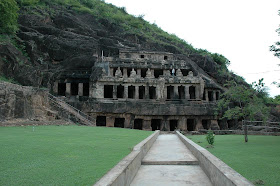 |
| Ananta Padmanabha Swami Temple |
Rock-cut architecture is the practice of creating buildings and other physical structures by carving natural rock. In India the term 'cave' is often applied, and in China 'cavern,' but one must differentiate natural caves from rock-cut architecture which is man-made and designed along the conventions of architecture itself and thus in every respect a part of architecture and its history. Though rock-cut architecture differs from traditional architecture in many obvious ways, many rock cut structures are often made to replicate traditional architectural forms in the facades and even in their interiors. The interiors were usually carved out by starting at what would wind up being the roof and then working downward, for the obvious reason that stones would not be falling on one's head. The three main uses of rock-cut architecture were temples (like those in India), tombs (like those in Petra, Jordan) and cave dwelling (like those in Cappadocia, Turkey).Rock-cut architecture is also said to be cut, hewn, etc., "from the living rock".
 |
| Amarnath |
The
Amarnath caves are one of the most famous shrines in Hinduism, dedicated to the god Shiva, located in the Indian state of Jammu and Kashmir. The shrine is claimed to be over 5,000 years old and forms an important part of Hindu mythology.Inside the main Amarnath cave lies an ice stalagmite resembling the Shiva Linga, which waxes during May to August and gradually wanes thereafter.This lingam is said to grow and shrink with the phases of the moon, reaching its height during the summer festival.According to Hindu mythology, this is the cave where Shiva explained the secret of life and eternity to his divine consort Parvati. Two other ice formations represent Parvati and Shiva's son, Ganesha.
 |
| Ajanta Cave |
The
Ajanta Caves in Maharashtra, India are 31 rock-cut cave monuments which date from the 2nd century BC. The caves include paintings and sculptures considered to be masterpieces of both Buddhist religious art (which depict the Jataka tales) as well as frescos which are reminiscent of the Sigiriya paintings in Sri Lanka.The caves were built in two phases starting around 200 BC, with the second group of caves built around 600 AD.
 |
| Barabar Cave |
The
Barabar Caves are the oldest surviving rock-cut caves in India , mostly dating from the Mauryan period (322–185 BCE), and some with Ashokan inscriptions, located in the Jehanabad District of Bihar, India, 24 km north of Gaya.These caves are situated in the twin hills of Barabar (four caves) and Nagarjuni (three caves) - caves of the 1.6 km distant Nagarjuni Hill sometimes are singled out as Nagarjuni Caves. These rock-cut chambers date back to the 3rd century BC, Maurya period, of Ashoka (r. 273 BC to 232 BC.) and his son, Dasaratha.
 |
| Khandagiri Udayagiri |
Udayagiri and Khandagiri Caves are partly natural and partly artificial caves of archaeological, historical and religious importance near the city of Bhubaneswar in Orissa, India. The caves are situated on two hills Udayagiri and Khandagiri, mentioned as
Kumari Parvat in Hathigumpha inscription and face each other across the road. They have a number of finely and ornately carved caves. It is believed that most of these caves were carved out huge residential blocks for the Jain monks, during the reign of King Kharavela. Udayagiri meaning Sunrise Hill, has 18 caves while Khandagiri has 15 caves.
 |
| Mahabalipuram |
Mahabalipuram was a 7
th century port city of the South Indian
dynasty of the Pallavas around 60 km south from the city of Chennai in Tamil Nadu. The name Mamallapuram is believed to have been given after the Pallava king Narasimhavarman I, who took on the epithet Maha-malla (great wrestler), as the favourite sport of the Pallavas was wrestling. It has various historic monuments built largely between the 7
th and the 9
th centuries, and has been classified as a UNESCO World Heritage Site.--
The historical village Mahendravadi owes its origin to Pallava:Mahendra Varman I (AD 580–630). According to an inscription in Pallava grantha this cave temple was excavated by Gunabhara on the bund of a large tank called Mahendra thataka in the city of Mahendrapura. The cave temple is formed by completely scooping out a large free standing boulder. Now the Garbagraha has an image of Narasimha.
 |
Mahendravadi |
The contribution of the Pallavas to the cultural development was significant. They had also encouraged the growth of Tamil and Sanskrit literature. The Pallavas had earned name and fame through their magnificent art and architecture. We know that Mamallapuram finds a prominent place in the tourist map of the world. Even today, their temples and sculptures stand testimony to the cultural achievements of the Pallavas.
.
The Whole content is taken from
Wikipedia.







nice post
ReplyDeleteThis is more than 1000 years old temple and every year on Sankranti festival sunrays touch the Idol only for few minutes. Thousands of devotees gather and see this event every year.
ReplyDeleteHi mohan,Thanks for having a look of my blog .
ReplyDeleteawesome sharing. amazing i love this
ReplyDeleteNice blog thanks for sharing. This is really great and very informatics blog. This show how India is known as land of devotees. We have planned a trip to India. Here can we find more information about India's temples: www.indiatemples.co.in
ReplyDeleteThis info is of great help.. Thanks for sharing.....................Vedic Architects & Sculptors a the leading Temple Architectural firms in Chennai and temple designer in India and abroad, and have been doing sculptures, vastu, stone carving and Monuments designers in Chennai.
ReplyDeleteTemple Designer In Chennai
Hi , I've read a few things on this site and I really do think that it has helped tremendously. There's still a heap I need to learn thus can continue learning and can keep coming back.
ReplyDeleteThanks.Sand suppliers in Bangalore